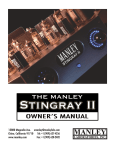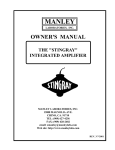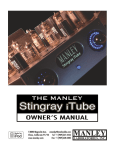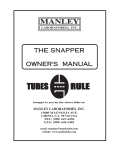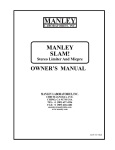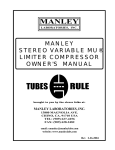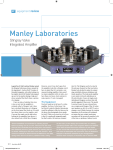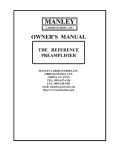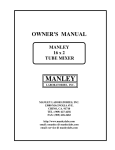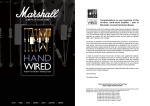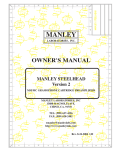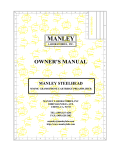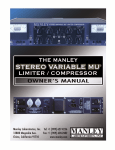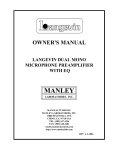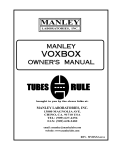Download Manley 50 WATT MONOBLOCK AMPLIFIER Owner`s manual
Transcript
MANLEY LABORATORIES, INC. OWNER'S MANUAL MANLEY STINGRAY INTEGRATED AMPLIFIER MANLEY LABORATORIES, INC. 13880 MAGNOLIA AVE. CHINO, CA. 91710 TEL: (909) 627-4256 FAX: (909) 628-2482 email: [email protected] Web site: http://www.manleylabs.com REV. 11-2-2005 CONTENTS SECTION PAGE INTRODUCTION 3 MAINS CONNECTIONS 4 OPERATIONAL NOTES 5 CONNECTING YOUR STINGRAY 6&7 SIMPLE TROUBLESHOOTING 8 FRONT PANEL, LAMP, BACK PANEL 9 TUBE LOCATIONS 10 SIDE PANELS 11,12&13 OPTIMIZING YOUR SOUND SYSTEM 14&15 TUBE FAQ 16&17 REPLACING TUBES & SETTING BIAS 18 CREDITS 19 SPECIFICATIONS 20 WARRANTY 21 WARRANTY REGISTRATION 22 2 INTRODUCTION THANK YOU!... for choosing the Manley STINGRAY integrated amplifier for your loudspeaker driving requirements. You have possibly chosen this product because you auditioned it in a store or heard it at a hifi show and were impressed with the sound. It may have been the right combination of price, power, features and styling for you. It may have been because you know the Manley Labs reputation for quality, reliability, and integrity. If any or all of these were the reasons, you made a good choice and for that, we thank you. The STINGRAY design evolved from our older Manley 50 Watt Monoblocks which were melded into a stereo chassis with basically a passive preamp. The 50 Watt Monoblocks had evolved from the Manley 35W monos and before that, the famous Tiny Triodes before that. (Yes, there were MANLEY Tiny Triodes too in the early 1990's!) Even harkening back to the mid-1980's, the earliest Manley designs were EL84 based, and Hutch still has one of these British-built single input with passive volume control stereo integrated EL84 amps on his test bench 20 years later. All of these little EL84 based amps featured sweet highs and three dimensional staging and imaging. But before it always seemed that they were a little whimpy in the bass. Why? Shouldn't be the tubes' fault. In 1997 EveAnna Manley set out to change that history. We first attacked and refined all performance aspects of the output transformers. After calculations and experiments, measuring and listening, we got our bass back (in big ballsy spades) with the new output transformer design, still used today. The advantages of a passive preamp are well known - near absolute transparency, no added noise and extreme signal path simplicity. The low amount of global feedback used in the Stingray which has one result of increased input sensitivity lends itself well to a passive front end. Then Paul Fargo stepped in to revise our older driver stage. This was the final icing on the Stingray audio circuit cake, and since 1997 the basic audio flow has remained unchanged. Minor refinements to the power supply and a few enhancements to the audio path have been over the years to the Stingray design, but overall it has been a stable product, and one of our best sellers. In 2005 we responded to numerous customers' requests to add even more preamp and switching features and at this point, we would consider it as crammed chock full of features and parts as we can muster in this chassis. Enjoy! Please read over this entertaining and enjoyable owner's manual carefully as it contains information essential to the proper operation and maximum enjoyment of this fine instrument. Many of the remarks contained herein are especially pertinent if the STINGRAY is to be your first long-term encounter with a vacuum tube power amplifier. Thank you again, and please enjoy your new STINGRAY! (and the clever Owner's Manual.) UNPACKING: Unpack the amplifier carefully by removing all the custom foam packing material and make sure that all supplied accessories are present. Carefully examine all items for any possibility of shipping damage. All of the tubes are already installed and should have survived the journey protected by their very own grey foam insert. They should be standing at attention in their sockets, and should show no signs of distress such as chipped glass, loose internal components or obvious breakage. If the amplifier is damaged or fails to operate, notify the shipper or your dealer or us or your local authorities immediately. Or if you suspect The Shipping People threw it off the airplane and onto your front porch whilst flying overhead at 30,000 feet, notify the shipping company without delay and complain to them as we only guarantee this unit to be able to survive a drop of 23,487 feet or less. Your STINGRAY was packed by Manny Q. with extreme love and each box includes the following components and accessories: a) 1 each, 6 foot IEC 3-conductor power cable (that you will probably replace with an expensive audiophile cord anyway.) b) 1 each, Owner’s Manual (that we hope you will keep reading.) c) 1 each, cheapo but perfectly functional METER for setting your bias It is prudent to retain the shipping materials for future use, as they are custom-formed for the amplifier and will greatly minimize the chance of shipping-related damage should you ever need to put your precious STINGRAY in the careless hands of The Shipping People again. We have heard that certain rodents might enjoy munching on the packing foam. We are sorry to report that we do not warranty the packing foam against attack by mice, rats, or other hungry critters, hungry children, hungry neighbors, etc. Try glue traps or spring-traps loaded with peanut butter to eliminate these unwelcome freeloaders from your property. 3 MAINS CONNECTIONS Your STINGRAY has been factory set to the correct mains voltage for your country. (Well, that is what we intended to do when we knew where it would be initially shipped.) The mains voltage that we built this STINGRAY to operate with is marked on the serial badge, located on the rear of the chassis. Check that this complies with what comes out of your wall. There is no voltage changeover switch! The power transformer's primaries must be either wired in parallel for 120v operation or in series for 230v or 240v countries so be sure to check the sticker and the serial number voltage indication for proper mains voltage. Failure to properly comply with mains voltage requirements can cause extensive damage to the system, which of course would not be covered by the warranty. If you relocate from, say, a 120v country to a 240v country, you will need us to rewire the Stingray's power transformer for you or get instructions from us to perform this operation if you happen to be as good at soldering as we are, or know someone who is. We are not telling you how to do this in this Owner's Manual because you need to pass a battery of tests for us before we will let you play with soldering inside the amplifier. Contact [email protected] for more details. Note: Stingrays shipped to Japan use a special 100v power transformer. The MAINS FUSE may be checked by first disconnecting the IEC mains cord from the power supply’s power inlet plug. Then gently push the light grey fuseholder retainer clip located next to the IEC power socket. The fuse and cap should spring outward toward your fingers. The fixed silver springy looking thing is NOT the fuse. Leave that alone. The fuse is a glass or white ceramic thing with silver end-caps. Inspect the mains fuse for the proper rating; change if necessary. Refer to the fuse rating chart in the specifications section of this manual. If you do not know what a blown fuse looks like, you may measure for continuity across the fuse ends. If your meter reads “OL” when you measure across the fuse, that means “Open Leads” and that would mean the fuse is blown. A blown fuse usually indicates A Very Bad Thing occurred. If this has happened to you, try to figure out why it may have happened. (Using a Fast Blow fuse when we have specified a SLO-BLO fuse is one reason, output tubes running away into never-never land are another reason.) If you have no idea why a fuse might have just blown on its own, you might want to consult with Manley Labs or your dealer for further advice as Something Very Bad might have occured, like the power transformer might have decided to retire early. One way this could happen is by running the wrong mains voltage into the unit. Be sure not to do that. If you live in a strange place... Export units for certain markets have a moulded mains plug fitted to comply with local requirements. If your unit does not have a plug fitted the coloured wires should be connected to the appropriate plug terminals in accordance with the following code. GREEN/YELLOW BLUE BROWN EARTH terminal NEUTRAL terminal LIVE terminal As the colours of the wires in the mains lead may not correspond with the coloured marking identifying the terminals in your plug proceed as follows; The wire which is coloured GREEN/YELLOW must be connected to the terminal in the plug which is marked by the letter E or by the safety earth symbol or coloured GREEN or GREEN and YELLOW. The wire which is coloured BLUE must be connected to the terminal in the plug which is marked by the letter N or coloured BLACK. The wire which is coloured BROWN must be connected to the terminal in the plug which is marked by the letter L or coloured RED. DO NOT CONNECT OR SWITCH ON THE MAINS SUPPLY UNTIL ALL OTHER CONNECTIONS HAVE BEEN MADE. (...or else...) 4 OPERATIONAL NOTES PREPARATION FOR INSTALLATION Budget a suitable space in which to place the amplifier and associated interconnect and mains power cable. This space should be free of strong external magnetic and RF fields, and reasonably removed from strong loudspeakergenerated acoustical fields. This space should also be free of excessive heat or dust and large enough to permit easy flow of cool air to the top, bottom and sides of the amps. Do not connect the STINGRAY to the AC mains until the other interconnections and items outlined below have been completed. Keep other associated equipment some distance away from the amplifiers. This will help keep airflow unrestricted, and cut down interference from radiated magnetic hum fields that can eminate from certain power supplies. Notice that the output tube’s glass envelopes are capable of reaching high temperatures, depending on operating circumstances. As with other equipment of this sort, it is best to keep the STINGRAY out of reach of pets or children, or be careful to keep children and pets away from the amplifier when in use. Or train them. Not too hard. People sometimes ask us why we don't supply a cage to protect children and pets from the scary exposed tubes. I always answer that I grew up with a tube receiver and survived ok and a cage would look ugly. The only physical harm that came to any of my family growing up from that tube receiver was once The Moving People dropped it on my mother's toe and broke it. (Broke the toe, not the receiver. It worked fine for many years after that. And Mom's toe is fine too.) And so did my little nephew who had one of my amps with scary exposed tubes from the time he was a wee lad. He not only survived and is in college now, but when he was three years old he knew how to fire up the whole hifi even before his mom did. So don't underestimate how smart your kids or pets are unless they are already prone to burning themselves on light bulbs. Or just put this amp up on a tall shelf out of the way. Actually I'd be more worried about little kids breaking my $3000 moving coil cartridge needle. Or The Cleaning People... Before plugging in your interconnects, take a quick visual inspection of the tubes. Sometimes either through shipping or unpacking things get jostled. Make sure all tubes are firmly in their sockets. You might also verify that none have turned white inside. That indicates that air has leaked inside the tube (or the vacuum leaked out!). Though it is rare, a tube is sometimes cracked or broken in shipping. It would need to be replaced before powering up the unit. Give us a holler if this happens to you. SWITCHING ON The power switch is located on the back panel. You shouldn't need to turn the Stingray around or get yourself behind it. You should be able to "feel" the rocker switch located next to the AC power cord. Flip the switch away from the power cord to turn on the Stingray or towards the power cord to turn off the unit. Easy 'nuff. RUNNING It is not recommended that you leave your Stingray always switched on. This only wastes electricity and tube life. Do you leave your lights on when you are not home? The Stingray reaches peak operating condition in approximately 30 minutes. Break-in from new is about a week although some people report it takes much longer. TUBE LIFE As with all tubes, their quality degrades with age. This is due to decreasing cathode emission, a natural process found in all tubes. We recommend that you have your amplifier checked every 4-5 years, depending on usage. An excessive increase in noise level or very unstable output tube bias can indicate the need to replace a tube. 5 CONNECTING YOUR STINGRAY Setting up this integrated amplifier is rather easy. Please refer to page 8 for a diagram of the back of the Stingray. 1. You will be connecting power last and turning the system on after all other connections are made to prevent ugly noises as wires are connected and to prevent possible damage to the amps and speakers. In general, it is best to make any connections with the power off or the volume control turned all the way down. With all tube amps, you MUST have speakers (or a load box) properly connected to the speaker terminals before power is turned on. Without a speaker, the voltage swings can be large enough to possibly cause an electrical arc inside a tube, tube socket or transformer and this may damage the amp. Solid state amps can usually be fine with a no-load condition but most of the time don't tolerate a short circuit. Most tube amps will tolerate a short for a little bit, but we try to avoid this. OK? 2. Before plugging in your interconnects, take a quick visual inspection of the tubes. Sometimes either through shipping or unpacking things get jostled. Make sure all tubes are firmly in their sockets and standing straight up. You might also verify that none have turned white inside. That indicates that air has leaked inside the tube (or the vacuum leaked out!). Though it is rare, a tube is sometimes cracked or broken in shipping. It would need to be replaced before powering the amp. 3. On rectangular chassis it is easy to specify front, back, sides etc - but on the 6 sided Stingray we should adopt a convention and call the sides that have the RCA inputs and input switching as Left-Back and Right-Back. We provide 4 left inputs on the Left-Back and 4 right inputs on the Right-Back. We realize splitting left and right this way with individual input select switches may be a problem for some - sorry. We did it this way because a good percentage of people rely on only one source 95% of the time and because it provides you with the maximum stereo separation and best signal flow. 4. Plug in your interconnects, one at a time, from each source, ie; CD, Tuner, AUX, then connect each input to the appropriate RCA jack on the Stingray. All RCA jacks are clearly labeled as to a typical function. Each input is functionally and electronically the same - only the labels are different. You may have to separate or split interconnects an extra 12 inches if they are the "paired" type or slide the loop that holds the pair together back so they will make the spread. If you need to connect a turntable (vinyl!) you will need a separate phono preamp to raise the level from the tiny signal from the cartridge, and apply the RIAA EQ curveso it will become a regular line level signal. The Manley Steelhead is a lovely choice for this application, for example. 6 5. Connect the speaker leads to the terminals on the top far left and far right of the Stingray. Be sure that the RED (+) positive terminal is connected to your positive (+) wire and the NEGATIVE (-) (white or black) terminal is connected to your (-) Negative wire. Connect the opposite ends to the speakers also RED (+) to RED (+) and Negative(-) to Negative(). This insures that your speakers will be "in-phase". All too often people accidently connect their speakers out-of-phase and it do sound strange. We have even seen this happen in hi-fi trade shows and record company executive offices. There is always some indication on the wire to help get "polarity" right but it may be as subtle as a "ridge" on the insulation or different colored conductors. Most high quality speaker interconnects are clearly labeled and/or color coded. Be sure that these connections are firm and solid. We do not recommend using pliers or a wrench to tighten the terminals because one can easily overtighten or mar the finish of the binding posts. Good finger tightening is usually the best. No need to be an ape. 6. Before proceeding to the next step (power!) check that the On/Off switch is Off and the volume is turned all the way down (anti-clockwise). Now connect the IEC power cable to the back of the Stingray and then the other end to your mains wall socket. 7. Turn on the On/Off switch and let the Stingray "warm-up" for a few minutes. You should be seeing the tubes begin to glow a bit. None should turn bright red - that would indicate a problem. Let us start off checking with a favorite CD. Be sure that both input select switches (Back-Left & Back-Right) are set to CD. Put the CD in PLAY and slowly turn up the Volume - You should be getting sound from both speakers. If not, turn the power off and check your connections from CD to Stingray and Stingray to Speakers. Sometimes we don't get an interconnect pushed in enough for good contact. Power up and try again. If you have sound, sit back and enjoy. Try your other inputs by turning the input selectors to each source. Sometimes if the switches haven't been used for awhile, the silver can tarnish a bit on the internal switch contacts. Just switching them back and forth a few times rapidly will clear this up. Excercise those switches once in a while. 7 Troubleshooting: It is rare that any of these problems occur but if they do here are some things to try. HUM - Try a mains ground adapter if they are legal in your country. Or try one anyway unless you fear the Electricty Police. A mains ground adapter is also called a "3 pin to 2 pin adapter" or a "cheater" and is available in hardware stores. There should be one ground to the wall in your system and only one. If two or more pieces of gear have 3 pin AC cables a ground loop can occur which will usually cause hum. The Stingray is probably the best grounded single piece as it is the center of your system. HISS - Usually one of the sources. This source may have a volume control that is turned down and forcing you to turn up the volume of the Stingray. Adjust the source so that it is a similar volume as your other sources. If it seems to be the one channel of the Stingray, then it is probably an input tube (12AT7WA). Most tubes should last many years but sometimes they get noisy prematurely. To verify, you can swap the two 12AT7s (with the power off) then test again. Be careful - tubes can be hot, don't bend any pins and gently wiggle the tube to remove it or insert it. Force should not be needed. BALANCE - The two speakers sound different - It may be the CD or source and the way it was recorded. First try a different source. Next try swapping the inputs. Power down and swap left and right inputs. If it is the source, then the problem will "follow" the swap. Return them to normal (L=L). Power down again and next try swapping the speaker connections by putting the left speaker wire in the right terminals and right wires into the left terminals. If the problem switched sides then the Stingray is suspect, if the problem stayed on the same side it is probably a damaged or fatigued speaker. ONE CHANNEL DEAD - Usually just a bad connection or an interconnect is plugged in wrong. Check your wiring. You can try any of the other 4 inputs and verify that both channels work on other inputs or not. The Balance Control is centered? You might try swapping the speaker interconnects at the Stingray end. If the problem swaps sides then it may be the Stingray. The two most likely problems is a bad tube (12AT7 or 6414) or a blown 250 mA (MDL 1/4) B+ fuse located in the Stingray. If you get NO BIAS READING on all 4 tubes on a channel, then you have blown that channel's internal B+ fuse located on the PCB inside the amp. Wait at least 20 minutes after turning off the amp and unplugging the power. There are about 400 volts DC on these fuses when power is on and it takes a while before the power supply capacitors discharge so there could still be volts there even when unplugged - so be patient and let the power supply discharge before taking off the bottom cover and poking around. There is a SHOCK HAZARD unless you follow these directions. The current is low and it is DC which means we are not talking "lethal" but it can hurt, arc and burn, not to mention make you jump and yell nasty four letter words. Also, use one hand - not two. Wearing a cotton glove insures that there won't be any surprises. TUBE GLOWS CHERRY RED. This is where you can see the plate area of the tube glowing red hot (they are normally gray or black and are the most visible part inside the tube).This indicates a bias problem or a bad tube; immediately attempt to re-bias the tube in question (see page 15). If the bias cannot be adjusted on that tube, immediatley turn off the power; the tube will have to be replaced. It is normal to see a slight blue glow that seems to coat the inside of the glass. It is also normal if a tube "flashes" bright white on turnon. Do not worry about this. 8 FRONT PANEL A C B A - BALANCE - This is a special Noble balance control. Unlike most balance controls, this one has no loss at center (detented) and can be considered to be a straight wire if it is in the 12:00 position. It only reduces the volume of one channel at a time B - VOLUME - This is also a high quality Noble conductive plastic precision attenuator. C - BACKLIT PANEL NOTE: Models produced after April 2003 use super bright LEDs for badge illumination, not incandescent lamps. The LED's will probably never burn out. But who knows...? This is the power indicator. If the IEC mains is properly connected and the On/Off Switch is "ON" and this panel does not glow then you probably have a blown mains fuse. It is located as part of the IEC socket assembly. If the badge does not glow but the tubes do and you have music then the illumination (LAMP or LED) is dead. It can be replaced easily. See the drawing below. The lamp looks just like a fuse .Do NOT put a fuse here. Replace it with a 12 volt, 0.15 amp, 1/4 X 1 1/4 lamp. It pulls straight up if the Stingray is upside down but you may need a hook or needle-nose pliers to get it started. Don't crush & break the glass. LAMP ACCESS BACK PANEL LAMP 1 0 D- FUSE COVER- Pry in the small slot to move the locking tab towards the fuse cover and it should pop open. Only use an MDL 3 SLO-BLOW fuse if it needs replacing (MDL 1.5 for 220V units). That's SLO-BLOW or TIME DELAY type fuse! E - POWER SWITCH -Towards the fuse or away from the IEC power cable is ON (1), towards the power cable is OFF (0). Because tubes require some time to warm up there is about 10 or 20 seconds of silence followed by "not good sound" before "wow". The best way to power up the system is sources (CD, turntable, etc) first, then after about 10 seconds - turn on the Stingray. Wait a minute or so - then you can turn up the volume and play tunes. This sequence prevents pops and thumps and may protect your speakers. Some people hear a difference after an hour or two but it will be a small improvement and nothing to worry about - this is normal, just warming up. Powering down is the opposite order - Stingray first. F - IEC MAINS SOCKET. This is where the power cable goes. Note that your amp should be wired correctly for your country. You may want to check the packing box to be sure. Also notice that this is a grounded 3 pin cable. If you get a hum problem, see the previous page for some simple troubleshooting hints. 9 IO D E/ U L AC TI VE /B YP AS S TR SU SE N D R EC O U T /L O O P R ET U R N O U B MAINS LO O P EC R ON/OFF T LO O P SS PA BY / VE B TI SU AC P L O U E/ LO D IO TR U O P O LO R U ET R U O T P O O /L B+ FUSE MDL 1/4 (underneath) FUSE WARNING: TO REDUCE THE CAUTION: DO NOT OPEN, RISK OF FIRE OR ELECTRIC HIGH VOLTAGE. SHOCK DO NOT EXPOSE TO REFER ALL SERVICING TO RAIN OR MOISTURE QUALIFIED PERSONNEL MANLEY LABS 13880 MAGNOLIA AVE CHINO, CA 91710 USA REPLACE FUSE ONLY PHONE (909) 627-4256 WITH THE SAME TYPE FAX (909) 628-2482 AND VALUE [email protected] SLO-BLO OFF / ON IEC MAINS POWER FUSE 3 AMP N T D N SE TOP VIEW C D D C ER VI D EO EO D VI X TU ER N N TU D + R KE EA P S S ER N X TU EL84 EL84 + X ER AU N TU EO VI D EO C D C AU X D VI S SP EA KE R 5 4 AU AU BIAS TRIMS BIAS TRIMS ADJUST FOR 250 mV DC WITH NO SIGNAL 8 1 2 3 5 6 7 4 6 - - 3 EL84 EL84 7 2 EL84 6414 EL84 6414 1 8 TP 8 TP 1 EL84 12AT7 12AT7 TP 7 ST TE TP G TP 5 TS IN PO TP 4 GROUND for BIAS MEASUREMENTS (BLACK LEAD GOES HERE) BALANCE TE ST TP 6 TP 3 BI AS AS BI PO IN TS EL84 TP 2 VOLUME TUBE LOCATIONS - See the diagram above for the proper tube locations. Power should be unplugged and the tubes cool before handling them. We label the tube sockets, test points and trimmers to help. It is possible to put tubes in wrong if you bend the pins - not good. On this diagram we added dashed lines to further clarify which test points are associated with which tube and which trimmer but they are numbered right on the chassis. Refer to pages page 16 to 18 if you are unsure about replacing tubes and setting the bias. A full description is given. Once that you've learned a bit about setting bias, we provide a bias trim pot and test point for each tube that should be referred to ground or TPG (The butt of the Stingray logo). Aim for .25V DC volts or 250 mV DC. All of the important info is silk-screened on the chassis. Notice that there are two fuses for the B+. These are 250 mA SLO-BLO ( MDL 1/4) types. They are supposed to blow with some types of tube shorts and prevent damage to the amps. ALWAYS let the amps sit unpowered for at least 20 minutes before attempting to check them out - SHOCK HAZARD - there can be very high volts here until the power supply capacitors discharge. See page 8 for details. 10 The Rear Panel Controls: In the summer of 2005 we added a bunch of features to the Stingray production version 3 that previously were available as add-on individual options. Read on to learn how to make the most of the Stingray in your system. Please note that when we describe an "input" we really are referring to the stereo inputs, left and right. There are two of everything, one set for left one set for right. Any of the four sets of stereo INPUT jacks can be used with any unbalanced RCA audio analog outputs from your source components. They are electrically identical and only differ in how we labeled them, keyed to suggested or typical usage. If you have balanced outputs on your source gear, check with the manufacturer on how to best interface them with unbalanced loads. Most balanced gear can deal with unbalanced loads by use of XLR to RCA converter plugs or special- made XLR to RCA cables. You'll just need to check with each piece to see if it is best to ground Pin 3 or to float it (not connect it). Transformer coupled outputs can always drive unbalanced inputs by hooking up the XLR Pins 1&3 gorunded to the RCA shield, and XLR Pin 2 to the RCA center "hot" pin. If you have questions, check with the manufacturer. CD-Plug in your audio outputs from your CD player or D to A Converter here. Kind of obvious. A good spot for the main L & R signals from a DVD deck. Do not patch lines marked "digital output", SPDIF, or AC-3 here though. Those are un-decoded digital signals and not audio (yet). VIDEO- Audio actually, from a VCR or Laser Disc player's audio outputs. You can run your stereo television or satellite receiver audio outputs in here. Again, watch out for AC-3, video output, or composite video labeled RCA jacks. The Stingray accepts analog audio signals only. TUNER INPUT- You can connect your FM/AM tuner outputs here. Another good input for a second VCR too. AUX- Plug your AUX in here.What is an AUX? It stands for auxiliary and basically means "extra" so this is just an extra input for any other source that we didn't label or that you have two of. You can use it for a tape deck playback or computer audio output, or iPod output with an 1/8" jack to RCA cable, for instance. Whatever you like. REC OUT / LOOP SEND- Here at the REC OUT, whatever input is selected on the input select switch will appear here. So you can plug this Recording output into a Tape Deck or CD Recorder or Computer Sound Card analog input to make recordings from whatever is playing and selected on your input selector. Note that this is not a buffered output so if your tape deck or recording device has a low input impedance, or if it does funny things like become a dead short when it is power off, like some IC inputs on certain CD recorders we do know of, you will load down the input to the Stingray (or short it out altogether and get no tunes!) Basically if you hear any difference or problems when your recorder is plugged in, or if it is plugged in and powered off and sounding weird, then we suggest that you just plug in when you are actually recording something. You can also use this output to drive another preamplifier in another room, for instance. Or if you wish to use another preamplifier instead of the passive one built into the Stingray, you can drive it here and run its outputs back into the Loop return. Another use of this Loop Send is to insert an equalizer, or an external crossover to bi-amp. You would drive that external crossover here, and come back in to the Loop Return after the crossover. 11 LOOP RETURN- This input comes in after the Input Selector and just before the Stingray's Balance and Volume controls. If you have all your sources going into another external preamplifier, or even a Home Theater surround processor, then you could plug that preamp's outputs here and let the Stingray just function as a stereo power amplifier when the Loop switch is set to Loop Active. The Volume and Balance controls still function in this mode. The Loop Send and Loop Return function as an insert point or effects loop, meaning you can insert something like a crossover, equalizer, or you can even monitor off your tape deck's 3rd head using the loop active switch as a tape monitor. SUB OUT- This is a line level output after the Stingray's volume control. Use this output to feed the input of your subwoofer amplifier. The signal level of the output follows the main volume control in the Stingray so that if you change the volume control on the Stingray, your external powered subwoofer amplifier will also track and change volume. Remember this is a LINE LEVEL output, not a speaker output. If your subwoofer only has speaker level inputs on it, then you need to drive it with the speaker outputs on the Stingray. TRIODE / ULTRALINEAR SWITCH- This switch changes the configuration of the output tubes and how the screen grids drive the output transformer. Triode mode hooks the screen grids up to the output tubes' anodes and will give you around 20 watts. UltraLinear, also known as "Partial Triode", connects the screen grids to the UL taps on the output transformer's primaries and will yield around 40 watts of output power. Triode mode tends to give you a more etheral and delicate sound while the UL mode has a more aggressive or punchy sound. Feel free to experiment and pick whatever operating mode you like the sound of best in your system. What will "sound best" really depends on your system and your room and your speakers and your tastes and what you are looking for. We do not suggest you play with this switch all the time. You should never switch up and down rapidly as there are high voltages on this switch and you'll blow something up quickly by nervously fidgeting with this switch. we strongly suggest you pick the setting you like best and just leave it there STINGRAY SIGNAL FLOW ONE CHANNEL SHOWN LOOP RETURN INPUT INPUT SELECTOR SWITCH REC OUTPUT / LOOP SEND LOOP ACTIVE BALANCE BYPASS LOOP SUB OUTPUT VOLUME TO STINGRAY AMPLIFIER 12 SPEAKER POSTS - The speaker connection posts are on the back side panel and labeled on the top panel. The RED is positive and WHITE (or black) is negative (ground). Be sure you have speakers (or a 4 to 8 ohm load resistor) connected to these terminals before powering the Stingray. Tube amps (unlike solid state) require a speaker if there is any chance there will be a signal applied. Watch out for reversing the positive and negative wires either at the amp or speakers (unless you want to simulate record company executive's office hi-fi). The lows get lost, and the image is very weird. If in doubt, try reversing one channel, the way with the most bass is correct. These terminals will accommodate most thicknesses of bare speaker wire and most U shaped terminals or banana plugs. The only thing that they don't like is thin wire. You should avoid thin wire for speaker cables in general. Use at least 18 guage (18AWG) or heavier. Bigger wire has smaller AWG numbers. Be sure that the top bolts are tight, but avoid over-tightening that might be difficult to undo or may damage the posts. In other words, firm as "strong finger tight" but less than "big wrench tight". These outputs are appropriate for speakers rated between 3 and 10 ohms which includes all those 4 and 8 ohm speakers. For reference, the amp design and output transformers were optimized for 5 ohms. You'll get a little less maximum power on either side of 5, but don't forget that your speaker manufacturer is giving you a nominal impedance figure when he tells you that you have "an 8 ohm speaker" which means your speaker's actual impedance swings wildly vs. frequency all over the place. In real life, we have 5 ohms to be a good place to be for most people. If you have some whacky speakers that hit strange extremes, then you might be a good candidate to order some custom other-impedance output trannies from our in-house magnetics department. REPLACING A TUBE, INDICATOR LAMP or FUSE. You should read pages 9,10 and 16 to 18 for more details. You may need a small #1 Phillips screwdriver and the correct replacement fuse, tube, or lamp. First be sure the unit is off and remove the IEC mains cable. Let it sit for 20 minutes to be sure all power supply capacitors are discharged otherwise you could still get a shock even though the unit is unplugged. Gently wiggle the tube around while pulling it out of the socket. Avoid bending the printed circuit board. Before putting a new tube in, look at it. Check to see that the pins are straight and that they line up to the socket. You should be able to gently push the tube into the socket without excessive force. If it is the indicator lamp that needs replacing, remove the bottom cover. Six screws near the sides hold it in place - when these are removed, the cover should slide off. You will see what looks like a fuse directly behind the black name panel. Gently pry the lamp out and replace it with another lamp and not a fuse. Replace the cover before powering up the unit. The mains fuse is in the IEC power connector sub-assembly. The fuse cover is a grey rectangle with a large slot and a small slot. The small slot is to help remove the cover. A fingernail or small screwdriver in the small slot is used to gently push or pry the tab towards the bulk of the grey cover. It should pop open. The two B+ fuses are located under the bottom cover; see pg 8 under "ONE CHANNEL DEAD" for details on replacing these. Refer to pg 20 for proper fuse types. 13 Optimizing Your Sound System This section is full of little hints that may help you get the most out of your stereo - and it may not cost anything or cost very little. Probably, you know most of this, but hopefully some of it may be new or refresh your memory or just be refreshing reading in a manual. A very important factor is your speakers. Hopefully you have good speakers and they are appropriate for this integrated amplifier. What is appropriate? Well, with 50 watt of tube power per side and probably a limited budget we would hope for reasonably efficient speakers so that the system will get loud enough for the music you listen to. The "spec" to look for is "sensitivity" or "efficiency". A speaker that is 95 dB efficient will easily get as loud with these 50 watts as 85 db speakers with 150 watts. "85" will do if you only listen to folk or chamber music. Usually you pay about the same for high sensitivity speakers but in amplifiers more watts is more $. By the way, many reviewers confirm that 50 tube watts is similar to 100 solid state watts. If you are buying speakers, it is wisest to carefully listen to them before buying. You will most likely like them longer if they tend to sound natural and real rather than over-emphasized in some area. In other words, think "accurate reproduction" not "numbers" and "hype". The price of speakers is often directly related to the low frequency response. Great lows generally require deep pockets and plenty of power. Thanks to "home theatre" there are a lot of powered subwoofers available that won't drain your resources. Get one that connects to speaker outputs so that it follows your input selection and volume control. This makes connecting them pretty easy. There are some very interesting speaker tricks. Most people just place them wherever it is convenient. Spouse approval is a real factor. We suggest that you experiment with speaker placement, then when they sound 100% better you bring in the spouse and demonstrate the difference. They should be able to hear the improvement and may totally agree with your choice. You should aim for equal distances between your listening position to each speaker and from speaker to speaker. The ideal is an "equilateral triangle". Try to get the speakers off the floor, and away from the walls (both side and back). The angle of the tweeter or speaker front panel to your face is also critical and experiment with that too. You should be getting a smooth frequency response so that highs and lows are balanced and mids not too prominent or distant. It should simply sound "natural". When we buy color TVs the first thing most of us relate to is flesh tones because it is something we all relate to and know when they are right. The equivalent thing in audio is vocal tone. We have evolved amazing discrimination for the varieties of human voice and much less for other instruments. Use a few well recorded CDs with vocals and adjust the speakers to get the most natural voices. If you are lucky, you will end up with a system that creates a 3D picture of the music that not only has left/right width but a solid distinct center. It should also make some sounds seem in front of the speakers and some behind. We have heard some systems with the Stingray even give an illusion of the height of the individual musicians. Most rooms are longer in one dimension. Some systems sound best with the speakers across the short dimension and the listening position part way back but not right at the back wall. Some systems are better across the long dimension. The only way to find out is to try. If you are getting this amazing imaging and soundstage, you may be interested why you suddenly have it now that you have the Stingray. These are very audible effects that seem to be beyond normal measurement technique or textbook electronic theory. This effect is directly related to the amount of negative feedback used in a design. The less feedback the greater the imaging. In transistor amplifiers it has been common practice to use more than 80 dB of negative feedback. Conventional designs need it because transistors are not particularly linear devices and it forces the circuit to get low distortion figures as well as very high damping factors. Tubes are much more linear and inherently low distortion. Tube amplifier designs use far less negative feedback (less than 20 dB) as a result . We speculate that the negative feedback may have a negative effect on transient accuracy. It is reasonably documented that the feedback does reduce the lower order harmonics in distortion but can raise higher order harmonics that are more audible. Feedback also makes the transition from clean to clipping very abrupt and abundant with high order harmonics. The best audio devices always seem to be simple & aesthetically balanced , with form following function. 14 You may have bought a great system but there is a good chance that you are only getting a fraction of it's potential. Very frequently we have experienced top quality electronics sounding unimpressive simply because acoustics were ignored. Even amongst studio engineers, few can really tell the difference between good speakers in a bad room and bad speakers in a good room - but they all know good speakers in a good room and very likely so do you. Acoustic techniques are better explained in books on recording studio construction. You can buy good ready-made acoustical materials and/or build them yourself for a fraction of the cost. Dollar for dollar, you can expect far greater improvement with acoustic treatment than expensive interconnects. Most people think acoustics is about sound-proofing but there is a lot of info available for improving the reproduction of music. Sound-proofing is usually expensive. Luckily just improving the acoustics in a room can be pretty painless. You may be able to change or move what is on the floors and walls (without getting expensive or ugly). The improvements may be dramatic. Number One on the bad list is parallel surfaces. That pretty much includes most rooms. Parallel surfaces can support a very short echo that is known as a standing wave. It boosts some frequencies and cuts others. This effect is often called comb filtering because of the multitude of peaks and dips. One cure is breaking up the big surfaces with a variety of smaller ones. The good news is that book shelves, curtains, wall hangings or macrame, plants, furniture and lamps all help. Not only does this balance live surfaces with dead ones but "checker-boarded" areas also act as a sort of diffuser. You can probably build low cost effective and attractive diffusers or have them made if you want something better (and more efficient). Number Two is very unbalanced room treatment. Both too "live" and too "dead" is generally bad. One might think that wall to wall carpets & curtains is going to be fine but watch out. All that stuff only eats highs and a little mids, but doesn't do anything to the lows. The lows end up very live in contrast to very dead highs. One way to balance this is get some thick absorbsion into the corners. Thick absorbsion in the corners is most effective to lows. The idea is to balance high and low absorbsion. Even normal speech sounds weird in near empty rooms with plain painted gypsum walls and hardwood floors. The simpler the decor the more intense the acoustic problems. The only hints we can offer is that the wall behind the speakers and behind you are often the most important. You can build some simple absorbers. Simply cut two 4'X8' pieces of 2" rigid fiberglass or open cell foam rubber into 16"X8' strips and wrap some white cloth around them. Easy, clean looking and cheap. Experiment, lean them against the wall at various places. Even very experienced acoustic designers experiment, listen then decide rather than attempting to predict every result. A variation is to use "perf-board" as a backing if you intend to stretch the fabric reasonably tight. It may also help with hanging the strips to the walls. Perfboard with a one or two inch space behind it is an alternative front surface to increase diffusion or can do double duty as a simple helmholtz absorber (for the low mids) and can be effective on the ceiling. You can hang a few up there either flush or dropped a few feet if you have the height to absorb lower frequencies. The wall behind the listening position is usually responsible for too much or too little lows compared with the rest of the room. Read up on slat and membrane absorbers for problems there - the panels described above won't help much for that. Number Three is lack of left/right symetry. In order to get the left and right similar sounding and getting a rock-solid center you should have identical left and right walls and distances. The ideal is a perfectly symetrical room but this may not be practical. Again, try to achieve this with positioning. Some of the "test" CDs have a variety of low frequency tones or sweeps. Use them to find rattles and buzzes in the room. Lamps and fixtures, some cabinets and components can do this. A little tape or glue can often fix these types of things. If you are getting serious about this kind of thing you can get a variety of test gear from measurement mics to real time analysers or computer software. These are useful tools but do not depend on the readings unless you are very experienced using them. Best to use your ears and use the test gear to verify what you hear and to document the changes. Remember that test gear neither makes records nor listens to music. Frequency measurement often ignores "time" and exagerates some factors and glosses over others. Steady tones are virtually useless in real rooms. The more comprehensive tests give complex data that needs to be correctly interpreted to be useful. Use 'em but don't jump to conclusions. Always use ears too. 15 TUBE FAQ A few general all-too-frequently-asked vacuum tube questions from the manleylabs.com FAQ as found on our website are answered here in case you don't have internet access (which we don't doubt because after all you bought vacuum tube amplifiers, didn't you?): (Don't take that comment personally. EveAnna still drives air-cooled Volkswagons... We're not perfect either.) FAQ #16. Do you sell tubes? I don’t know what you’re talking about. FAQ #16a. I need to retube my Manley amplifier. Do you sell tubes? Sorry. Just kidding. Yes, of course we do. We have about 100,000 tubes in stock of the several major types we use. FAQ #16b. Why should I buy tubes from you? We are only as good as our worst tube. We are very selective about which tubes we use in Manley products and we have several different testing and burn-in jigs to test for certain parameters which will be most important for that tube in a given circuit. We will test and select a tube set for you that will be optimized for your Manley piece of gear and in most cases, your tube set will actually be tested in another one of what you have. FAQ #16c. Are tubes expensive? Not especially. Although I might have made a killing in the stock market had I invested the money I instead put into finding and stocking these large quantities of tubes ten years ago when the USA military were dumping their stocks of NOS JAN vacuum tubes. Seriously, there is the stocking cost to consider in the cost we must charge, development charge of the computerized test jigs we built, then more importantly the time it takes one of our guys to run a little tube through its qualification procedures. Remember, a given tube cannot be improved during testing. It is the way it is, and one hopes it stays that way. It can only be selected, and in selecting that tube that will work really well for your piece of gear, we probably had to throw away several. In some cases we might have had to go through 30 tubes to find the quietest one, or the one with the lowest microphonics, or the one with the best internal matching, depending on what parameters are important for that circuit. That is all factored into the cost somewhat, but no, overall, we don’t charge enough for replacement tubes. FAQ #16d. NOS? JAN? What does that mean? New Old Stock. Joint Army Navy. Yes our military used to use vacuum tubes. As long as the glass doesn’t break, tubes are impervious to a nuclear explosion’s electromagnetic pulse unlike little silicon devices whose little junctions would go poof! FAQ #16e. Good to know. How long do tubes last? Some of them are dead out of the box. Some tubes don’t make it through burn-in and after a few days they just go noisy or quit. Sometimes UPS sabotages our shipments and after all our testing efforts the tube arrives broken at your place. Sometimes a tube decides to end it all early and intentionally misbehaves after a few months. Other tubes are real troopers (like my 98 year old neighbor) and run strong for 30 years. We have documented cases of power tubes in Manley amplifiers going over 60,000 hours non-stop in recording studios 24/7/365 without a re-tube. In one case in particular, the amplifiers were never turned off and had their own dedicated air conditioning for the amplifier rack they lived in. This certainly contributed to their long life. 16 More silly vacuum tube questions... FAQ #16f. Should I turn off my gear between uses? While power cycling is a factor for ultimate tube life, there also is a fixed number of electrons that can ultimately jump off the cathode. In general we do recommend if you aren’t using the gear for more than a few hours you should power it down. Do you leave the lights on in your house when you are away? FAQ #16g. But it sounds different when you first turn it back on. What is the warm-up time for this gear? I generally recommend 45 minutes warm-up time for everything to reach operating temperatures and sound like it’s supposed to. FAQ #16h. What about break-in time for new gear? We burn in the gear for a couple of days before it is shipped out. Folks report that after about a week of break-in that it sounds better. Some of the more fussy people of course report that full break-in takes much longer.... FAQ #16i. How do I know a tube is broken? All the vacuum has leaked out. FAQ #16i.i After the vacuum leaks out, where does it go? Is there some way to collect it and put it in another tube, to make it last longer? You have to suck really hard. FAQ #16j. No really, how do I know a tube is broken? Usually a tube whose glass has been broken or cracked usually will have a white powdery like substance inside it where all that silvery stuff used to be. No, it is not cocaine and we didn’t put it there.. FAQ #16k. Does the glass explode? I haven’t seen it happen. Usually the glass will just crack at the base of the tube if it is going to physically break due to a sudden change in temperature and “all the vacuum will leak out”. FAQ #16l. Other than outright failure of a tube, how do I know when it is time to re-tube? Generally speaking, for the small tubes, if you notice an unacceptable increase in background noise (“hiss”) then the tube who is responsible for making the gain in the circuit probably needs to be replaced. The tube(s) making the gain will usually be shorter than the output tube. Common types we use for gain in most of our circuits will be 12AT7, 6201, 12AU7, 5814, 12AX7, 5751, or 6072. The output buffer tube in most of our line-level circuits will be either the 7044, 6414, or 12BH7. These tubes usually don’t cause too much trouble and either work or don’t work. Turn the lights off and see if you see the little tubes glowing. Look for one that looks like it has cocaine in it. For the power tubes in our amplifiers, after a few years if you notice a small revolt going on where several of the output tubes are misbehaving or getting hard to bias, you might consider doing a full re-tube. Keep the old ones that did not join the revolution as emergency spares. FAQ #16m. Can I change a tube myself? R.T.F.M. Do you call in specialists to change your light bulbs for you? 17 What should I know about BIAS? Bias is a simple DC (negative) voltage that sets, what is called, the "operating point" of the tube. For our purposes it "fine tunes" the current going through the tube. We want each of the 4 tubes per channel to be equally sharing the load. This gives the amplifier's lowest distortion and the tube's optimum life. When we set "bias" we are adjusting that voltage and measuring the current at a pin called the cathode. The cathode is connected with a 10 ohm 3 watt resistor that allows the more convenient voltage measurements from terminals right on the top panel. These 10 ohm resistors also have a second job. They are fuses in case of a really nasty tube failure. Sometimes a tube will die in a way that burns up this resistor (with a little puff of smoke) and then with a new tube you will only measure zero at the terminal for that tube. The resistor should be replaced by a technician, but it should only take ten minutes. Can you solder? How often should I check these BIAS points? Some people never do. It really should be done when you change a tube and it is very likely that a little adjustment will be needed. We suggest that you check every 3 months - that way you are assured that the amp is running optimally and will spot a tube on its way out. Some check every month, once a week is getting a little obsessive. What tools do I need? Just two. A small flat screwdriver (insulated handle) to adjust the trimmers. You also need a voltmeter or multi-meter. You don't need a good one. Analog or digital (preferred) will do and you can get one that is perfectly adequate for about $25 to $50 as long as it measures DC volts between 0.1 (100mV) and 1 volt. In the USA, RadioShack sells acceptable inexpensive meters. What do I do? The amp should be well warmed up (30 min.) and no music playing. Set the meter to read DC volts. The meter has two test leads, red and black. Put the black lead in the black terminal on the top marked TPG (ground) or touch the metal point to the steel chassis (but not a painted or anodized part). Put the red lead in the first red terminal marked TP1. The meter should read either .25 V or 250 mV(same thing). If it doesn't you need to adjust BIAS 1 trimmer until it does. It doesn't need to be exact - .23 to .27 will do. Now move the red lead to the red test point labelled TP2. Same thing, if it is not .25 adjust BIAS 2 so that its close. Continue till all 8 points have been done. If you trimmed a few, you should re-check because there is a little interaction and you may want to fine tune a bit. What if the reading is drifting up and down? Some drift is normal. It is caused by the AC mains changing and by a little very low frequency noise in the tube. If one drifts above .3 or below .2 then you may be seeing a tube begin to go bad. Watch it for a while or check it every few weeks noting changes. This tube should be replaced probably. With mains changes all the tubes drift together and you may see more long term drift. Another cause is that you forgot to stop the music. What if I can't trim a tube into range? If all you get is zero or near zero on one terminal it means either the tube or 10 ohm resistor is dead and needs replacing. If it is too high then it probably is the tube. If you look at the tubes, that one will probably be cherry red. Get a new tube. If all the terminals read zero on one channel, then the B+ fuse is likely blown on that side. If all the terminals read zero on both channels but the amp still plays, then you have a problem with the meter. Is there any advantages to biasing higher or lower than .250? This is the optimum trade-off between tube life and cross-over distortion. If you bias a little higher you may lower distortion a bit but shorten tube life a lot. If you bias lower the distortion climbs fast and the tube life will lengthen partially because you won't want to listen as often or as long. 18 CREDITS An EveAnna Manley Production Featuring concept, layout and industrial design by EveAnna Manley, Starring: Paul Fargo for Input Innovations Hutch for Output Outovations Mastered by: Baltazar Hernandez Titled by: J. Gordon Holt Contributing Players: Michael Hunter Marcelino Tornez Elias Guzman transformer specialist assembly supervisor silk screens and PCBs It all began at the HI-FI '97 show, at the bar of course -J. Gordon Holt with his traditional martini, and EveAnna Manley with her stimulant of choice, a cup of coffee. She was describing this new integrated amplifier she wanted to build and drew a one of those legendary "bar napkin drawings". Gordon remarked "It looks like a stingray" (the fish, not the car) - and so, in honor of Gordon, we call this little jobbie "The Stingray". The Power Amps are from David's 50 watt Monoblocks with newly developed transformers from Michael and Hutch (for exceptionally clean highs and more power in the lows). The passive PreAmp came from EveAnna and her talent of finding just the right parts. The Input stage was developed by Paul to further extend the HF response. Balta did all the circuit board and metal work drawings and assembled the prototypes - no small feat. Speaking of small feet, we machine each foot and knob in-house. Marcelino oversees the entire assembly process and designed one of the PCBs. Paul strenously tested every prototype and Hutch, as usual, just listened. You can blame this silly manual on Hutch. Why not? (But EveAnna and Humberto mucked with it too.) 19 SPECIFICATIONS Output Tubes: 8 x EL84 Ships with Ei 6BQ5 Driver Tubes: 2 x 6414 Ships with GE or RAYTHEON JAN NOS USA or 6414W Input Tubes: 2 x 12AT7WA Ships with: Ei 12AT7 large plate Lamp type 1/4 X 1 1/4, 12 volt, .15 amp NOTE: Models produced after April 2003 use super bright LEDs for badge illumination, not incandescent lamps. The LED's will probably never burn out. MAINS Fuses:120VAC operation: MDL 3 AMP / 250 Volt SLO-BLO 240VAC operation: MDL 1.5 AMP/ 250 Volt SLO-BLO B+ FUSES (2): MDA 1/4 AMP, 250 Volt SLO-BLO, located internally Maximum Output Power UL mode: 40 Watts x 2 channels 1.5% THD @ 1kHz Maximum Output Power TRIODE mode: 20 Watts x 2 channels Frequency Response: 15 Hz - 40 kHz, -1dB Gain: 37 dB at max Volume Input Sensitivity: 185 mV in = 50 watts out into 5 ohms Input Sensitivity Triode: 66mV in = 1W into 8 ohms Input Sensitivity UL: 53mV in = 1W into 8 ohms S/N Ratio: typically 87 dB A-WGT, 20Hz-20KHz Input Impedance: 50 Kohm nominal Optimum Speaker Load: 5 ohms Actual Output Impedance at 20Hz: 2.8 ohms at 100Hz: 2.6 ohms at 1KHz: 2 ohms Damping Factor: 5 Power Consumption Idle: 200W Maximum Power Consumption at Full Power: 370W Power Cord: Detachable IEC standard. Appropriate power cord supplied for destination country Dimensions: W= 19", D=14", H= 5 1/2" Shipping Weight: 30 lbs. 20 WARRANTY All Manley Laboratories equipment is covered by a limited warranty against defects in materials and workmanship for a period of 90 days from date of purchase to the original purchaser only. A further optional limited 5 year transferrable warranty is available upon proper registration of ownership within 30 days of date of first purchase. Proper registration is made by filling out and returning to the factory the warranty card attached to this general warranty statement, along with a copy of the original sales receipt as proof of the original date of purchase, or registration can be made online in the Tech Support section of www.manleylabs.com. This warranty is provided by the dealer where the unit was purchased, and by Manley Laboratories, Inc. Under the terms of the warranty defective parts will be repaired or replaced without charge, excepting the cost of tubes. Vacuum tubes and meter or badge lamps are warranted for six months provided the warranty registration is completed as outlined above. If a Manley Laboratories product fails to meet the above warranty, then the purchaser's sole remedy shall be to first obtain a Repair Authorisation from Manley Laboratories and return the product to Manley Laboratories, where the defect will be repaired without charge for parts and labour. All returns to the factory must be in the original packing, accompanied by the Repair Authorisation, and must be shipped to Manley Laboratories via insured freight at the customer's own expense. Factory original packaging can be ordered from Manley Labs. Customer will be charged for new factory original packaging if customer fails to ship product to Manley Labs in the original factory packaging. After repair, the product will then be returned to customer via prepaid, insured freight, method and carrier to be determined solely by Manley Laboratories. Manley Laboratories will not pay for express or overnight freight service nor will Manley Laboratories pay for shipments to locations outside the USA. Charges for unauthorized service and transportation costs are not reimbursable under this warranty, and all warrantees, express or implied, become null and void where the product has been damaged by misuse, accident, neglect, modification, tampering or unauthorized alteration by anyone other than Manley Laboratories. The warrantor assumes no liability for property damage or any other incidental or consequental damage whatsoever which may result from failure of this product. Any and all warrantees of merchantability and fitness implied by law are limited to the duration of the expressed warranty. All warrantees apply only to Manley Laboratories products purchased and used in the USA. All warrantees apply only to Manley Laboratories products originally purchased from an authorised Manley dealer. Warranties for Manley Laboratories products purchased outside the USA will be covered by the Manley Importer for that specific country or region. "Grey Market" purchases are not covered by any warranty. In the case that a Manley Laboratories product must be returned to the factory from outside the USA, customer shall adhere to specific shipping, customs, and commercial invoicing instructions given with the Return Authorisation as Manley Laboratories will not be responsible for transportation costs or customs fees related to any importation or re-exportation charges whatsoever. Some states do not allow limitations on how long an implied warranty lasts, so the above limitations may not apply to you. Some states do not allow the exclusion or limitation of incidental or consequential damages, so the above exclusion may not apply to you. This warranty gives you specific legal rights and you may also have other rights which vary from state to state. For Tech Support and Repair Authorisation, please contact: Manley Laboratories, Inc. 13880 Magnolia Ave. Chino, CA. 91710 Tel: (909) 627-4256 Fax: (909) 628-2482 www.manleylabs.com 21 WARRANTY REGISTRATION We ask, grovel and beg that you please fill out this registration form and send the bottom half to: MANLEY LABORATORIES REGISTRATION DEPARTMENT 13880 MAGNOLIA AVE. CHINO CA, 91710 USA Or you may FAX this form in to: +1 (909) 628-2482 or you may fill in the online warranty registration form found in the Tech Support section of our website www.manleylabs.com or you can be really diligent and register your warranty three times to see if we get confused! Registration entitles you to product support, full warranty benefits, and notice of product enhancements and upgrades, even though it doesn't necessarily mean that you will get them (Just kidding!) You MUST complete and return the following to validate your warranty and registration. Thank you again for choosing Manley gear and reading all the way through The Owner's Manual. (We really mean that sincerely, the bit about thanking you for choosing our gear. THANK YOU!!!) MODEL STINGRAY SERIAL #__________________ PURCHASE DATE ______________ SUPPLIER ______________________ -------------------------------------------------------------------------------------------------------PLEASE DETACH THIS PORTION AND SEND IT TO MANLEY LABORATORIES MODEL STINGRAY SERIAL #__________________ PURCHASE DATE ______________ SUPPLIER ______________________ NAME OF OWNER _______________________________________________ ADDRESS ______________________________________________________ CITY, STATE, ZIP ________________________________________________ EMAIL: ________________________________________________________ TELEPHONE NUMBER___________________________________________ COMMENTS OR SUGGESTIONS?__________________________________ ________________________________________________________________ 22






















